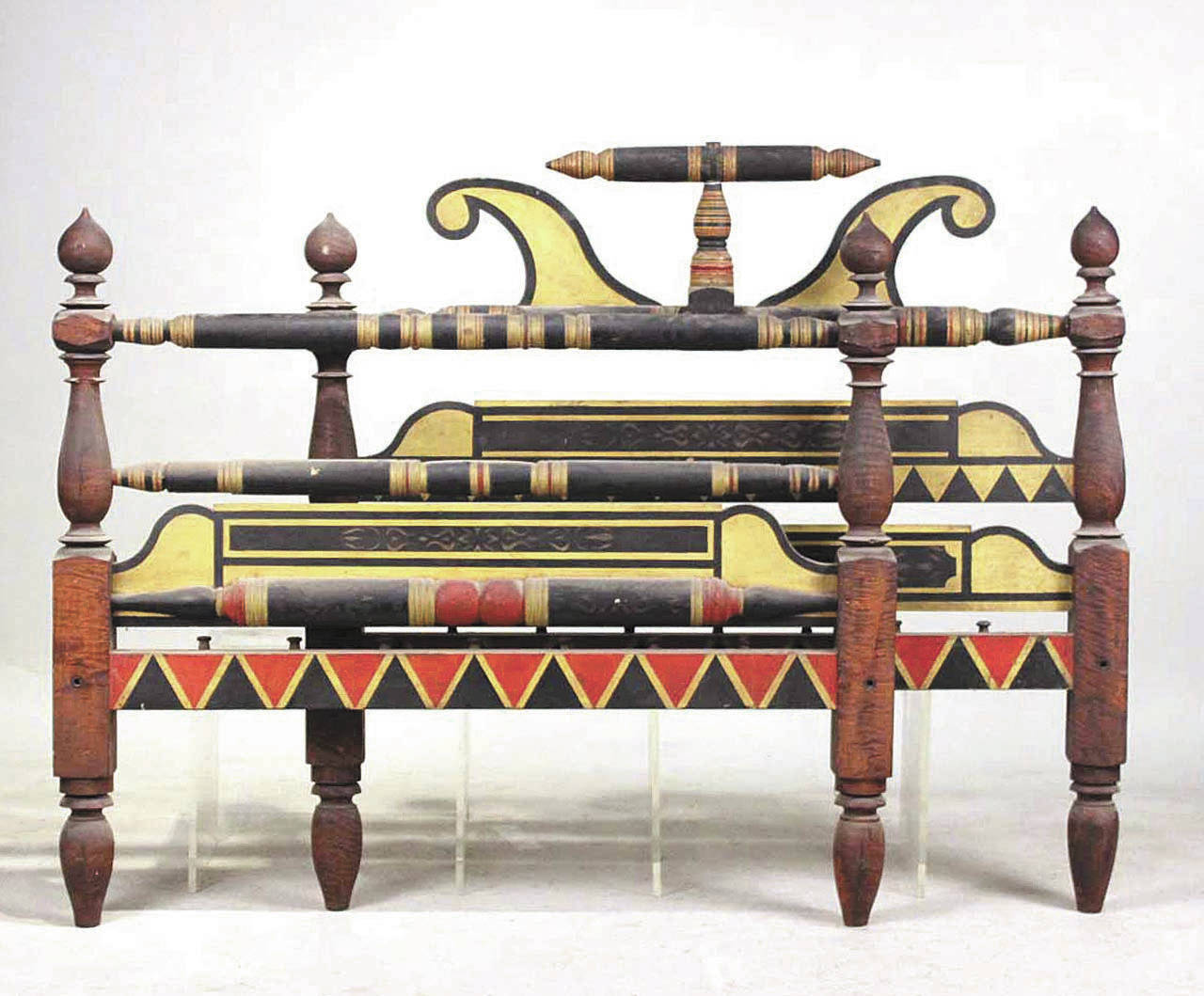Can an antique bed be used in a modern home without difficulties? Yes and no.
The beds used before about 1900 are shorter and narrower than the standard sizes used today. That means to use the beds, the fitted sheets, blankets, box springs and mattresses may have to be custom made. It might be possible to use toppers or foam rubber instead of springs. But then the top of the bed will be lower than normal.
Until the late 1800s, the mattress was held in the bedframe with wooden slats or rope. An old rope bed will have holes in the side rails to “rope the bed.” Some old beds have pegs in the side rails. These hold a mattress with “sacking,” a piece of sailcloth with eyelets that match the positions of the pegs. It is strung into place in the center of the frame to hold the mattress. Ask a local antique dealer, historical house curator or search online for “roping a bed” for instructions.
An antique bed is shorter than a new one. Sometimes it is best to use just the head- and footboards and buy a modern metal frame.
A colorfully painted antique Empire bed made in New England was auctioned by Nye & Co. recently for $12,500.
Q: I bought a pickle castor with an undamaged embossed glass container and a silver frame at a house sale. I was told it was made by Mt. Washington Glass Works. Is it valuable?
A: Mt. Washington Glass Works was founded in 1837 in South Boston, Massachusetts. The company moved to New Bedford, Massachusetts, in 1870. It merged with Pairpoint Manufacturing Co. in 1894. Pickle castors sell for a few hundred dollars to a few thousand dollars. Size, decoration, condition and frame material determine price. Pickle castors with solid silver frames sell for about twice as much as those with silver plated frames. If yours is plated, it is worth about $150 to $250.
Q: I have a silver spoon marked with a small hallmark: the letter “S” in the middle of wings. I’d like to know the maker and when it was made.
A: This mark was used by George W. Shiebler, who started his company in Baltimore in 1876. He moved to Brooklyn and the company name became George W. Shiebler & Co. in 1891. It went out of business in 1910. The company made flatware, hollowware, souvenir spoons and specialty items. A sterling teaspoon is worth about $25 to $50. A plated teaspoon sells for only $10 to $15.
Q: I have an old cast iron bell stamped B.C. Taylor. It’s 12 inches high and 16 inches wide and in good condition but rusty. What is the value of this bell?
A: B.C. Taylor Agricultural Works was founded in Dayton, Ohio, in 1862. The company made horse-drawn hay and grain rakes. Hay rakes were farm tools used to collect cut hay or straw into rows so it could be dried and collected quickly and efficiently. The business met hard times in the 1870s and cut back, but still exhibited at neighboring state fairs and even the Paris Universal Exposition of 1878. Business revved up again in the early 1880s as B.C. Taylor and Son, when the foundry also made bells — industrial, farmhouse, dinner and school bells. The company was out of business by about 1909. Your school bell is worth about $250.
Q: I have a small wooden box that my mother kept jewelry in. It is lined in red and inside the lid is a gold seal that says “Medal of Honor, Republic of Barcelona, Buren, 100th Anniversary” with the dates 1842-1942. I’ve seen several of these for sale online but never with information. Can you tell me anything about it?
A: In 1842, a few watchmakers opened shops in Buren, a town in Switzerland on the River Aare. They made watch parts and later, a few watches a day. Demand for the watches grew and a factory was built in 1867. The shops were brought together under one roof and the Buren Watch Co. name was registered. Their excellent work received recognition in timepiece-making competitions, one of which was the 1929 International Exposition at Barcelona, Spain, where it was awarded the Grand Prix Medal of Honor. In 1966, the Buren Watch Co. was sold to Hamilton Watch Co. and who made their watches. Buren went out of business in 1972, but the brand name is still used by Swiss Watch Editions of Hamburg, Germany. Your box originally held a Buren watch. The seal inside commemorates the 1929 award and the 100th anniversary of watchmaking at Buren. We found an empty box like yours that sold for $30.
Tip: Be sure that any restorer, refinisher or upholsterer working on your antique is insured.
Write to Kovels, The Daily Herald, King Features Syndicate, 628 Virginia Drive, Orlando, FL 32803.
Talk to us
> Give us your news tips.
> Send us a letter to the editor.
> More Herald contact information.

























